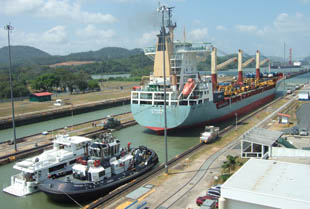A dream comes true for me as I make the historic crossing from Atlantic to Pacific
I’ve always been fascinated by the Panama Canal: its magnitude as an engineering feat; the human cost; and its extraordinary and lasting global importance.
Over the years I’ve read a number of books about its history. I hoped I’d get a chance one day to go through it. Well, I just have and it really is a dream come true.
From the Caribbean to the Pacific, the canal is 48 miles long and raises vessels up to a height of 25m above sea level. It took 30 years to build, give or take. Over 75,000 men worked on it over those years (about a third from Barbados) and it cost over $350 million at a time when the average worker’s pay was a dollar a day.
Diseases such as typhoid and yellow fever took such a toll on the workers that construction had to cease until public health improvements were made. Over the long saga of the building of the canal a staggering 27,000 workers lost their lives.
The scale of the labour that created it is frightening. I learned that the blasting of rock, mostly to hack out the seven-mile Gaillard Cut connecting the Pacific end locks to the Gatun Lake, took 60 million tonnes of dynamite.
The transit is a really exciting experience. I joined Swiss sailors Charles and Marie Stutz, who are taking part in the World ARC, and were part of a group of 15 boats that locked through together this weekend.
I’ll be writing about this in much more detail in the magazine in a couple of the next issues, but here are a few photos and captions showing some of the procedure.

We arrive at the first of the three Gatun locks, at the Caribbean side of the canal at the prearranged time of about 1900.
We already have our Panama Canal adviser on board. Each yacht has to have one and ours was a cheery and informative man named Ahmed, shown here talking to skipper Charles.

We had already formed rafts, known in canal-speak as nests, before entering the lock. The canal authorities issue the nesting arrangements, usually three yachts abreast and with catamarans (if there are any) in the centre because their twin engines make them a bit more manoeuvrable. The lead adviser is on the middle boat which is driving the nest and he issues instructions on manoeuvring as a group.
Each Gatun lock takes you up 27ft – feet are the official Canal height measurement. It’s a lot more than it sounds and the turbulence is quite severe, especially in the first sea lock. Which is not too surprising considering that more than 50 million litres of water are flooding in.

You can see that a container ship was in the parallel chamber locking up at the same time as us. The flights can be operated in either direction and timings controlled by adjusting the water rate through feeder pipes from 17ft diameter culverts on each side of the lanes.

From daylight the following day, this photo is of a line handler. Two of these, bow and stern, throw a light heaving line with a monkey fist on to the outermost yachts, you tie it on to a long line and they make these fast in the lock.
The line handlers are very skilled and can make the monkey fist land pretty much where they want. Some flick the wrist like spin bowlers. There are regular inter-lock competitions for accuracy, distance and height.

The photo at the top of this page and this detail show the Miraflores lock on the Pacific side and a ship coming the other way. Ships are pulled along by electric locomotives. There are six per ship, four on bow lines and two at the stern.
The locomotives run alongside the edges of the locks on a rack and pinion system. Wndlasses adjust the steel cables. They aren’t computerised; it’s all done on voice command from the pilot on board.
The biggest ships able to transit – Panamax size, or 294m LOA and 32m beam – clear each side by less than 0.6m. It’s highly skilled stuff.
Going back to our journey through the three Gatun locks, once you’re through you are instructed to anchor for the night round the corner. The adviser is taken off and returns the following morning at about 0600.
Then begins a long morning motoring through the lake. Gatun Lake is a huge body of water with many uninhabited, jungly islands and big bays and inlets. I had not been prepared for how unspoilt and quiet and beautiful it is. It’s like cruising up the Amazon. We could hear monkeys howling on some of the islands.

After 20-odd miles you go through the Gaillard Cut section, the part of the canal the engineers despaired of ever finishing because it was blasted through rock, shovelled out by hand and progress was dogged by heavy rainfall and incessant landslides.
Then you reach the single Pedro Miguel lock and descend by 27ft. Going down is much easier as there’s no turbulence to contend with.

This photo shows me doing the bow line of the Stutz’s Hallberg-Rassy 48 with some help from the Ahmed the adviser.
Finally you go down through the two Miraflores locks, beneath the Bridge of the Americas that joins the two continents and out into the Pacific.
From anchoring in The Flats near Colon to await your adviser to dropping him off again after the Bridge of the Americas near Panama City takes around 24 memorable hours.




